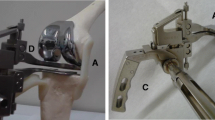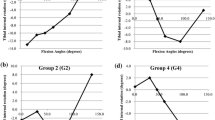Abstract
Recently, we developed a new tensor for total knee arthroplasty (TKA) procedures enabling soft tissue balance assessment throughout the range of motion while reproducing post-operative joint alignment with the patello-femoral (PF) joint reduced and the tibiofemoral joint aligned. Using the tensor with a computer-assisted navigation system, we investigated the relationship between various intra-operative joint gap values and their post-operative flexion angles. An increased value during the extension to flexion gap and a decreased value during the flexion to deep flexion gap with PF joint reduced, not everted, showed an inverse correlation with post-operative knee flexion angle, not pre-operative flexion angle. In conclusion, understanding the characteristics of joint gap kinematics in posterior-stabilized TKA under physiological and reproducible joint conditions may enable the prediction of the post-operative flexion angle and help to determine the appropriate intra-operative joint gap.




Similar content being viewed by others
References
Anouchi YS, McShane M, Kelly F Jr, Elting J, Stiehl J (1996) Range of motion in total knee replacement. Clin Orthop Relat Res 331:87–91
Lizaur A, Marco L, Cebrian R (1997) Preoperative factors influencing the range of movement after total knee arthroplasty for severe osteoarthritis. J Bone Joint Surg Br 79-B:626–629
Harvey IA, Barry K, Kirby SP, Johnson R, Elloy MA (1993) Factors affecting the range of movement of total knee arthroplasty. J Bone Joint Surg Br 75-B:950–955
Parsley BS, Engh GA, Dwyer KA (1992) Preoperative flexion. Dose it influence postoperative flexion after posterior-cruciate-retaining total knee arthroplasty? Clin Orthop Relat Res 275:204–210
Ritter MA, Stringer EA (1999) Predictive range of motion after total knee replacement. Clin Orthop Relat Res 143:115–119
Matsumoto T, Tsumura N, Kubo S, Shiba R, Kurosaka M, Yoshiya S (2005) Influence of hip position on knee flexion angle in patients undergoing total knee arthroplasty. J Arthroplasty 20:669–673
Dennis DA (2001) Problems after knee arthroplasty. The stiff total knee arthroplasty: causes and cures. Orthopedics 24:901–902
Harvey IA, Barry K, Kirby SPJ, Johnson R, Elloy MA (1993) Factors affecting the range of movement of total knee arthroplasty. J Bone Joint Surg Br 75-B:950–955
Kawamura H, Bourne RB (2001) Factors affecting range of flexion after total knee arthroplasty. J Orthop Sci 6:248–252
Schurman DJ, Matityahu A, Goodman SB, Maloney W, Woolson S, Shi H, Bloch DA (1998) Prediction of postoperative knee flexion in Insall-Burstein ll total knee arthroplasty. Clin Orthop Relat Res 353:175–184
Schurman DJ, Parker JN, Orstein D (1985) Total condylar knee replacement. A study of factors influencing range of motion as late as two years after arthroplasty. J Bone Joint Surg Am 67-A:1006–1014
Joshi AB, Lee CM, Markovic L, Murphy JCM, Hardinge K (1994) Total knee arthroplasty after patellectomy. J Bone Joint Surg Br 76-B:926–929
Fehring TK, Odum S, Griffin WL, Mason JB, Nadaud M (2001) Early failures in total knee arthroplasty. Clin Orthop Relat Res 392:315–318
Sharkey PF, Hozack WJ, Rothman RH, Shastri S, Jacoby SM (2002). Insall award paper. Why are total knee arthroplasties failing today? Clin Orthop Relat Res 404:7–13
Bellemans J, Banks S, Victor J, Vandenneucker H, Moemans A (2002) Fluoroscopic analysis of the kinematics of deep flexion in total knee arthroplasty. Influence of posterior condylar offset. J Bone Joint Surg Br 84-B:50–53
Victor J, Bellemans J (2006) Physiologic kinematics as a concept for better flexion in TKA. Clin Orthop Relat Res 17 August 2006 [Epub ahead of print]
Kim YH, Sohn KS, Kim JS (2005) Range of motion of standard and high-flexion posterior stabilized total knee prostheses. A prospective, randomized study. J Bone Joint Surg Am 87-A:1470–1475
Matsumoto T, Tsumura N, Kurosaka M, Muratsu H, Kuroda R, Ishimoto K, Tsujimoto K, Shiba R, Yoshiya S (2004) Prosthetic alignment and sizing in computer-assisted total knee arthroplasty. Int Orthop 28:282–285
Matsumoto T, Tsumura N, Kurosaka M, Muratsu H, Yoshiya S, Kuroda R (2006) Clinical values in computer-assisted total knee arthroplasty. Orthopedics 29:1115–1120
Muratsu H, Tsumura N, Yamaguchi M, Mizuno K, Kuroda R, Harada T, Yoshiya S, Kurosaka M (2003) Patellar eversion affects soft tissue balance in total knee arthroplasty. Trans Orthop Res Soc 28:242
Dorr LD, Boiardo RA (1986) Technical consideration in total knee arthroplasty. Clin Orthop Relat Res 205:5–11
Insall JN, Binazzi R, Soudry M, Mestriner LA (1985) Total knee arthroplasty. Clin Orthop Relat Res 192:13–22
Insall JN, Tria AJ, Scott WN (1979) The total condylar knee prosthesis: the first 5 years. Clin Orthop Relat Res 145:68–77
Siebert W, Mai S, Kober R, Heeckt PF (2002) Technique and first clinical results of robot-assisted total knee replacement. Knee 9:173–180
Sparmann M, Wolke B, Czupalla H, Banzer D, Zink A (2003) Positioning of total knee arthroplasty with and without navigation support. A prospective, randomized study. J Bone Joint Surg Br 85-B:830–835
Stulberg SD, Loan P, Sarin V (2002) Computer-assisted navigation in total knee replacement: Results of an initial experience in thirty-five patients. J Bone Joint Surg Am 84-A:90–98
Matsumoto T, Muratsu H, Tsumura N, Mizuno K, Kuroda R, Yoshiya S, Kurosaka M (2006) Joint gap kinematics in posterior-stabilized total knee arthroplasty measured by a new tensor with the navigation system. J Biomech Eng 128(6):867–871
Matsueda M, Gengerke TR, Murphys M (1999) Soft tissue release in total knee arthroplasty. Clin Orthop Relat Res 366:264–273
Bottros J, Gad B, Krebs V, Barsoum WK (2006) Gap balancing in total knee arthroplasty. J Arthroplasty 21(4 Suppl 1):11–15
Mihalko WM, Krackow KA (1999) Posterior cruciate ligament effects on the flexion space in total knee arthroplasty. Clin Orthop Relat Res 360:243–250
Kadoya Y, Kobayashi A, Komatsu T, Nakagawa S, Yamano Y (2001) Effects of posterior cruciate ligament resection on tibiofemoral joint gap. Clin Orthop Relat Res 391:210–217
Acknowledgments
The authors acknowledge Mrs. Janina Tubby for her assistance in preparation of this manuscript.
Author information
Authors and Affiliations
Corresponding author
Rights and permissions
About this article
Cite this article
Matsumoto, T., Mizuno, K., Muratsu, H. et al. Influence of intra-operative joint gap on post-operative flexion angle in osteoarthritis patients undergoing posterior-stabilized total knee arthroplasty. Knee Surg Sports Traumatol Arthr 15, 1013–1018 (2007). https://doi.org/10.1007/s00167-007-0331-y
Received:
Accepted:
Published:
Issue Date:
DOI: https://doi.org/10.1007/s00167-007-0331-y




